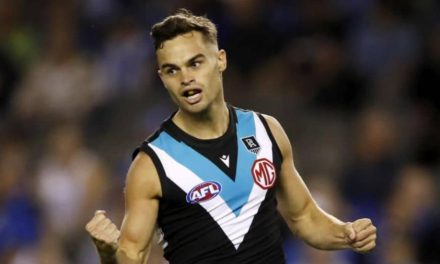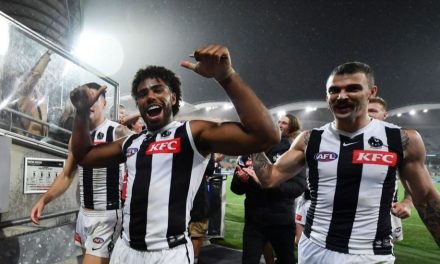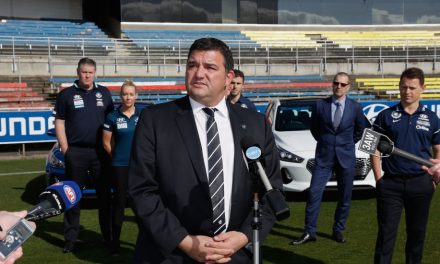2018 was one of the great grand finals, but that hasn’t stemmed the debate about the game’s start time. Photo: AFL MEDIA
There’s always uncertainty surrounding the beginning of a new football season. But it’s fair to say that when it comes to the AFL in 2019, there’s a little more even than usual.
Much of it is as glorious as ever, the stark frailties of teams not good enough to mix it with the best yet to be exposed, optimism the drink of choice. But there’s uncertainty this year about more than the prospects of various teams, players and coaches.
Even the coaches, those masters of control, are apprehensive about the extent to which they may lose their grip on the game this season.
And that’s not just about no longer being able to get messages to their players out on the ground at will, team runners now prevented from entering the arena until after a goal has been kicked.
That’s just one of nine rule changes in total coming into AFL football in 2019, several of which may have a more profound impact on the game than most we’ve previously seen.
Like the 6-6-6 rule at centre bounces, for example, requiring each side to place a half-dozen players inside either 50-metre arc and the area in between, the closest the game has yet come to full-scale zoning.
That will not only affect how coaches structure their midfielders’ rotations, but their forward and defensive set-ups besides, starting one or two extra men behind the centre square to counteract a better-equipped opponent at the bounce no longer an option.
Defensively, the abolition of the rule requiring a player kicking-in from a behind to kick to himself before playing on, and the pushing back of the man on the mark to 10 metres rather than five, theoretically has opened the door for more transition from defence to attack.
Coaches won’t find it so easy now to clog up the attacking half of the ground, dwell on a defensive error, and lock the ball inside their own forward 50. Kick-in strategies are just another aspect which will require a coaching rethink.
Players are, rightly, as anxious as anyone going into a new season, six months of training about to be put to the best. They too, obviously, will be feeling their way with the new rules.
But, on a broader scale, they, too have other concerns. Player welfare generally is becoming a bigger issue within the AFL. As the purer joy of playing the game for fun at junior level gives way to the professional workplace, so with it comes all its attendant demands and stresses.
More players than ever are reporting, and seeking treatment for mental health issues, dealing with depression, the risks of various addictions.
Their post-career may not provide much respite either. One of the bubbling issues with which the game continues to deal is the impact of repeated concussions on physical and mental well-being.
Legal action has been brewing for some time now on behalf of a range of former players, including some of the biggest names in the game a generation ago, such as Hawthorn’s Brownlow medallist John Platten and dual Brownlow winner and Sydney and Carlton legend Greg Williams, Geelong and Essendon ruckman John Barnes and Melbourne high-flyer Shaun Smith.
They have reported terrifying post-career symptoms such as seizures, memory loss, mood swings and anxiety. A lawsuit could be filed at some stage this year, say the legal people, the AFL waiting on that possibility with trepidation.
AFL fans are a joyous bunch at this time of the year, a six-month drought about to be broken, their weekend rituals returning along with their emotional, passionate investment in the fortunes of their clubs.
Yet even they are uncertain about the state of play beyond this weekend’s first round. Where is the AFL headed? Who can say, as the game in a heritage state like Tasmania withers on the vine despite the agreement of a large part of the football community that it should be playing a part in the national competition beyond hosting “home” games for Melbourne clubs.
Fans have witnessed the bizarre AFLX tournament, in which players became pseudo comic book superheroes in one-off “teams”, the whole exercise creeping uncomfortably close to a giant advertisement for Marvel, the new naming rights holder for the league’s own Docklands stadium.
Now, the Western Bulldogs have given over their famous jumper for the first game to display an image of Marvel creation Thor. Where does the commercialisation end?
And when does the AFL stop playing the football public for saps in the now annual “debate” about a twilight or night grand final? It tells the fans they are what the game is about, but also insists the night timeslot is “inevitable” despite more than three-quarters of fans repeatedly rejecting the idea, as the TV broadcasters bully away in the background.
That’s football the product. AFL football the game, however, is a happier talking point, Carlton and Richmond again kicking off a season, 173 days after Dom Sheed’s now-famous boundary line goal iced a premiership for West Coast.
The Eagles are every chance of going back-to-back, too, but not without stiff competition from the likes of their premiership predecessor Richmond, which finished 2018 two games clear of its rivals but torched a whole campaign with a poor preliminary final.
Collingwood, so close on grand final day, is right in the mix again, and Melbourne, flagless since 1964, has very real prospects of breaking the competition’s longest premiership drought.
Barely a club right now doesn’t have at least some sense of hope. Essendon hasn’t won a final of any description for 15 years but the Bombers have landed another big fish in Dylan Shiel and have high hopes. So does North Melbourne, which was almost universally tipped to finish in the bottom two last year but now eyes off September instead.
That’s the sort of unpredictability which makes so many of us so wedded to our indigenous game. We fret about its welfare a lot, and we ponder the wisdom of so many decisions about its future being taken on our behalf.
But as the first of another 207-game marathon gets underway at the MCG on Thursday evening, there is one guarantee. That the endless possibilities which go hand-in-hand with that first bounce are at least one uncertainty to be treasured.
*This column first appeared at INKL.











